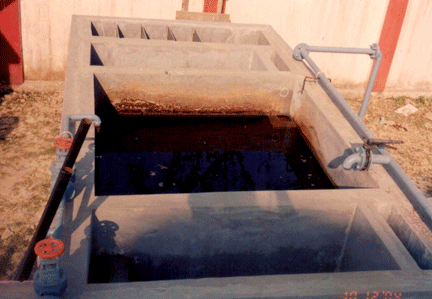| Typical Raw Effluent Quality for Moderate BOD Wastewater | |
| pH | 6-9 |
| BOD | 800-1000 mg/l |
| COD | 1500-2500 mg/l |
| TSS | 200-500 mg/l |
| Oil & Grease | 20-50 mg/l |
| Typical Outlet Parameters after Secondary Treatment | |
| pH | 6.5 - 8.5 |
| BOD | < 30 mg/l |
| COD | < 250 mg/l |
| TSS | < 100 mg/l |
| Oil & Grease | < 10 mg/l |
The Treatment Process
Raw Effluent from entire factory will flow by gravity to Anaerobic Digestor through a Bar Screen Chamber. In this chamber bigger size solid particles (>10 mm particle size) as well as leaves, twigs etc. will be separated. Then the whole waste is passed through the Anaerobic Digestor where Effective Micro-organism (EM) will be dosed on a fixed dosing pattern. The Anaerobic unit will then be filled with millions of small granules or particles of sludge consisting of bacterial strains of EM. These sludge particles are held in a blanket and provide a large surface area on which organic matter are attached and undergo bio-digestion or biodegradation. A high solid retention time (SRT) occurs within the tank. The total treatment process and the operation involve no usage of mechanical equipment, less manpower requirement and ease of operation. The bacterial strains of EM will form a sludge blanket at the bottom of the tank within 20–25 days time after which the load on the tanks will come down substantially. For proper growth & maintenance of micro-organisms special bacteria (EM) culture will be dosed periodically.
Then the whole waste is pumped to an Aeration Tank/ SAFF Reactor/ FAB Reactor, where removal of organic matter will take place. The type of reactor will be decided based on area available at site, underground/ aboveground process, height restriction etc. In this Reactorfixed surface/ floating surface/ diffused aeration system will be provided for effective mixing & aeration necessary for proper growth of micro-organisms. For proper growth & maintenance of micro-organisms special bacteria (EM) culture will be dosed periodically.
The effluent comprising of the biological floc from the Reactorwill overflow into Tube/ Plate/ Lamella Settler or Secondary Clarifier where they will settle down at the bottom. This underflow sludge will be recycled back by the Sludge Pump to the Reactorto maintain the population of micro-organisms. Excess sludge will be periodically transferred to Sludge Drying Beds or passed through a Filter Press, where sludge will be collected & disposed off whenever required. The overflow water will then be discharged to municipal sewer.
Advantages of the Technology
1] Low Project Cost
2] Minimum Operating Cost
3] Easy & Minimum Maintenance
4] Can Handle Shock Load
 |
||
| Aeration Tank & Lamella Clarifier | ||
| Click to enlarge |
